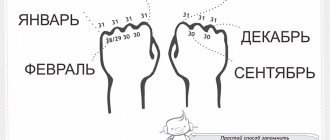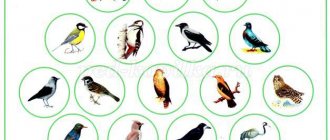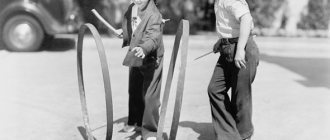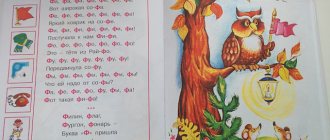Card index of didactic games card index of the world around us (senior group) on the topic
Card index of didactic games
"What is good and what is bad".
Goals: To teach children to distinguish good behavior from bad; Pay attention to the fact that good behavior brings joy and health to both yourself and the people around you, and, conversely, bad behavior can lead to unhappiness and illness.
Demonstration material: Excerpts from their works of art, life facts about the good and bad behavior of a person, children, or group.
Progress of the game: Children use facial expressions and gestures to express their attitude towards good and bad behavior (bad behavior - make an angry face, shake a finger; good behavior - smile, nod their heads approvingly). Answer the teacher's questions.
Sample questions: Today Seryozha ate snow again. Guys, is this good or bad? Children show with facial expressions and gestures that this is bad.
What could happen to Seryozha? The children answer.
"Noble Deeds"
Goal: To cultivate in children the desire to do things for the sake of other people. To form an understanding that we call an action not only heroism, but also any good deed for the sake of another person.
Material: ball
Progress of the game: Children are asked to list noble deeds towards girls (women) and boys (men). The teacher throws the ball into the hands of one of the players, he names a noble deed and throws the ball to the next player at his request.
For example, noble deeds for boys: call a girl only by her name; when meeting a girl, say hello first; give up your seat in transport; never offend a girl; protect the girl; help the girl carry heavy things; when a girl gets out of the transport, you need to get out first and give her your hand; the boy must help the girl get dressed, give her a coat, etc.
Noble deeds for girls: call a boy by name only; when meeting a boy, say hello; praise the boy for showing attention; do not offend or call the boy names, especially in the presence of other children; thank the boy for his good deeds and deeds; etc.
"Bag of Bad Deeds"
Progress of the game: Children receive black paper blots, the teacher offers to put them in a bag, and tell them what bad things he did today, as well as put negative emotions in this bag: anger, resentment, sadness. And when the children go for a walk, this bag is thrown away.
"Flower of Good Deeds"
Material: flower made of multi-colored cardboard, the petals are removable and inserted into the middle.
Progress of the game: You can play the game individually with a child, or with a group of children. Children are invited to collect the “Flower of Good Deeds”; for this, each child needs to take a petal and say some good deeds. Children list positive actions one by one, and the adult connects the petals to the middle. When the flower is collected, the children applaud each other.
“How do I help at home?”
Objectives: To form ideas about the household responsibilities of women and men, girls and boys. Cultivate a desire to help people.
Material: flower made of multi-colored cardboard, petals are removable, inserted into the middle
Progress of the game: Children take turns tearing petals from a flower, naming the duties they perform in the family (watering flowers, sweeping the floor, caring for animals, “raising” younger sisters and brothers, repairing toys, etc.). You can diversify the game. Let the children list the responsibilities that their mothers and then their fathers perform in the family.
"Let's compliment each other"
Goals: To teach children to be attentive to each other, to be able to show sympathy for children of the same and opposite sex. To consolidate knowledge about the qualities of masculinity and femininity.
Material: Any flower (it is better if it is not artificial, but live).
Progress of the game: The teacher brings a “Magic Flower” that will help the children express their feelings. Children are encouraged to pass the flower to any child and compliment them. If someone is ignored, the teacher pays a compliment to these children.
"Wishes"
Goals: To teach children to be attentive to each other, to be able to show sympathy for children of the same and opposite sex. To consolidate knowledge about the qualities of masculinity and femininity.
Material: heart toy (any toy)
How to play: Children stand in a circle. Passing a toy to each other, they say their wishes: “I wish you...”
Progress of the game
Educator: Our cards are mixed up, we need to place them in the sun or a cloud. If the deed is good , then go to the sun. If the deed is bad , then to the cloud. Mandatory condition: the child must tell what is shown in this illustration, a good or bad deed and why .
Bad words: how to wean a child from swearing Article 'Bad words: how to wean a child from swearing' Article Bad words: how to wean a child from swearing. Sooner or later, parents can.
Conversation “Good and bad deeds” Goal: To form clear ideas about good and bad deeds. Cultivate positive character traits: kindness, patience, politeness.
Didactic game “On a walk through Supsekh” This manual contributes to the formation of knowledge about the history of our native village, traditions, culture, people living next to us and the education of patriots.
Didactic game for children with disabilities “Nakhodilki”. Game from a hardware store Didactic game for children with disabilities "Nakhodilki" Game from a hardware store, because the idea for this game appeared while visiting the store. A didactic game to introduce children to folk arts and crafts. Didactic game “Make a Pattern” The art program in kindergarten provides the following tasks for decorative drawing: learn to draw based on Russian embroidery.
Consultation “Good Habits” How to form good habits in a child You need to start forming good habits as early as possible. For example, teaching a baby to fall asleep.
Consultation for parents “How to wean a child from saying “bad” words” When one day a young child uses a swear word in a conversation, there is no limit to the suppression of parents. Where did he hear them? Why does he pronounce them?
GCD summary for social and communicative activities in the middle group “Good and bad deeds” GCD summary for the middle group for social and communicative development “Good and bad deeds.” Goals 1. Create an emotionally positive experience.
Lesson summary “Polite words and good manners” Purpose: To consolidate the ability to use polite words in children’s speech; teach children to correctly name individual pieces of utensils and form ideas.
Project “Polite words and kind deeds” Project topic: “Polite words and kind deeds” Project type: educational, short-term. Project duration: 2 weeks Participants.
Didactic game “Bad or Good”
Irina Tartabaeva
Didactic game “Bad or Good”
educational game
«Bad or Good»
Didactic game " Good or bad "
- an activity for preschoolers.
In a playful way, the teacher instills moral standards in the students. Children learn to distinguish good deeds from bad , and the rules of behavior in certain life situations are fixed in their memory.
The game can be played by children of junior and senior preschool age.
The purpose of the didactic game is to develop an understanding of which actions are good and which are wrong, how to behave correctly in different life situations, and how to determine the correctness of other people’s actions.
Tasks:
• Teach children to distinguish good behavior from bad ;
• To promote the accumulation of experience in children of friendly relationships with people around them and nature;
• Foster a negative attitude towards rudeness and greed;
• Cultivate an attentive attitude and love for people and the world around them;
• Develop the ability to collaborate.
The game material consists of petal cards depicting various situations, as well as circles in the form of two emoticons (sad and happy, circles of two colors (red and green)
by the number of participants in the game.
Preliminary work: Conversations on the topic: “Good and bad deeds ”
,
“What you can do and what you can’t do”
.
Option 1.
Children divide the petal pictures into two groups, into good and bad deeds, and attach them to the corresponding emoticon.
Children explain why they put a petal on this flower
Option 2.
The task can be made more complicated: Children divide the petal pictures into two groups, into good and bad deeds and attach them to the corresponding emoticon, explain why they put this flower on it.
For each illustration depicting incorrect behavior, there is a picture with a similar situation where the character does the right thing.
Children are looking for a similar situation: a bad and a good deed
Option 3.
Can be used for classes in the senior dosh. WHO. For the lesson, you need to prepare green and red circles (one red and green circle for each child)
.
The green circle means "
good " , the red circle
"
bad " . The teacher shows and reads out the situation, and the children raise one of the circles depending on the situation.
For example: “A child draws on wallpaper - is it good or bad ?”
Children raise a red circle.
This is how the flower of good deeds .









